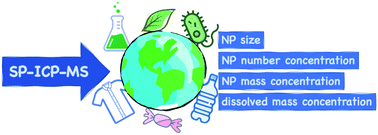Analytical applications of single particle inductively coupled plasma mass spectrometry: a comprehensive and critical review
Abstract
Single particle inductively coupled plasma mass spectrometry (SP-ICP-MS) refers to the use of ICP-MS as a particle counting technique. When ICP-MS measurements are performed at very high data acquisition frequencies, information about (nano)particles containing specific elements and their dissolved forms can be obtained (element mass per particle, size and number and mass concentrations). As a result of its outstanding performance, SP-ICP-MS has become a relevant technique for the analysis of complex samples containing inorganic nanoparticles. This review discusses the maturity level achieved by the technique through the methods developed for the detection, characterisation and quantification of engineered and natural (nano)particles. The application of these methods in different analytical scenarios is comprehensively reviewed and critically discussed, with special attention to their current technical and metrological limitations. The emergent applications of SP-ICP-MS in the field of nanoparticle-tagged immunoassay and hybridization methods are also reviewed.

- This article is part of the themed collections: Analytical Methods HOT Articles 2021 and Analytical Methods Review Articles 2021


 Please wait while we load your content...
Please wait while we load your content...